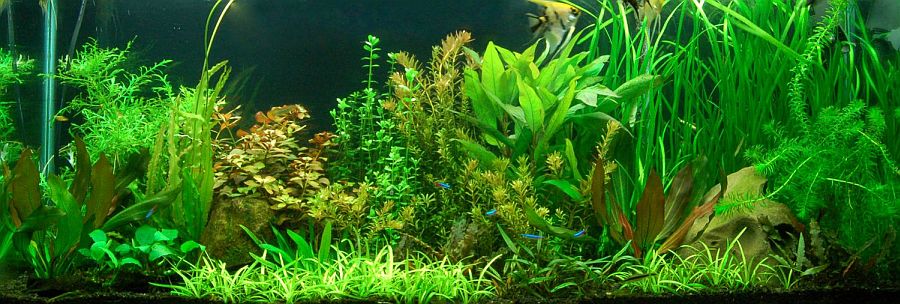








|

Stem Plants
This article addresses techniques for planting and trimming stem plants.
Matt Helgeson's five month aquarium pictured above and achieved by using our setup advicePlanting Stem Plants In The Substrate
Stem plants are often difficult to keep in the substrate when initially planting. They are usually cut so that they do not have roots, and they are planted individually and spaced apart, making the small stem mass difficult to keep in the substrate. This article will address our method for getting stem plants to hold in the substrate, and also trimming techniques.
Stem Plant planting Technique
First, take the individual stem and hold it between your middle finger and your thumb. Now take your index finger and make a two inch hole in your substrate. Place the stem that you are still holding between your thumb and middle finger in the hole, and using your index finger begin to push substrate into the hole. Now you can pack that substrate down around the stem plant, firmly, but not so hard that you crush the stem, of course. You will create an indent around the stem lower than the level of the main substrate. Fill it in repeatedly, packing the substrate down each time until you are level with the main substrate level. Now, pull up on the stem about a half an inch! Your stem plant will stay put and be ready to happily grow in the substrate!
Stem Plant Trimming
Stem plants require frequent trimming to maintain their original beauty and while exceptions can be made to trimming stem plants at a uniform level, for example, in a concave aquascape we want the stem plant species bunch to slope down to the center if it is on the end towards the middle, we still do not want individual stems poking above the rest. We want to create a neat and tidy curve or line where the tops of all of that species of stem plant is located. A sharp scissors is best used for this purpose and even better is the curved tip scissors to allow you to point the scissors down to trim. As you trim the species of plant, the result will be multiple shoots regrowing of of each stems cut point, creating a bushier effect than just the single top. At each trimming, cut further up on the plants. The stem plants, which were somewhat sparse initially, will increase their volumes with repeated trimming and create a denseness to the entire aquascape. Their leaves will become smaller and provided a sense of depth. After a period of time, the lower parts of the stem plants will become "woody", at which time it is important to cut the tops of the stem plants and repeat the process all over again. When you use stem plants in a layout, take their individual characteristics into consideration and avoiding placing the same leaf shapes and colors side-by-side
Nutrition For Stem Plants
Fertilizing stem plants is mainly done by using the appropriate liquid fertilizers, or powdered fertilizers if you are dry dosing. Of course they need the appropriate levels of the macro nutrients, nitrate, phosphate, and potassium, and the micro nutrients plus iron. I am a big believer in root tabs being used in the substrate for stem plants as well! Even if you are using planted aquarium substrate! There are some species that only do their best with the addition of root tabs such as Pogostemon Stellata, Ludwigia Cuba, and Alternathera Reineckii. Contact me for help on fertilizing ingredient purchase, or dosing if need be. You can reach me at FERTILIZER INFORMATION
Aquatic Scapes
P.O. Box 1115
Faribault, MN 55021
Telephone: 507-331-5801
Fax: 507-384-3146
©Copyright Aquatic Scapes 2002-12
All rights reserved
